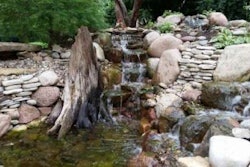Japanese beetles begin to make their appearance at this time of year. Landscapers should be on the lookout for the voracious feeders, which are known to go after more than 320 plant species, including roses, birch, linden, grapes, raspberries, Norway maples, beans, apples, plum, crabapples, elms, beech, asparagus and rhubarb.
 Photo: www.pestkill.org
Photo: www.pestkill.orgThe beetles, typically about a half-inch long with shiny metallic-green bodies, coppery brown wings, and white hairs along their sides and backs, were first introduced to the United States in New Jersey, but their geographic range has expanded to include Minnesota, Iowa, Missouri, Arkansas, Georgia, and Alabama.
Vijai Pandian, a horticultural educator for the Brown County, University of Wisconsin Extension, writes in the Green Bay Press Gazette that the following steps can be taken to manage Japanese beetles:
- Protect small plants such as roses, vegetables, strawberries, and raspberries with a floating row cover from afternoon until late evening hours.
- For small beetle populations, handpick and drown in soapy water.
- Spray small woody ornamentals, perennials, and annuals with synthetic insecticides that contain carbaryl, imidacloprid, permethrin, bifenthrin or malathion. (Read product labels for instructions and bee-toxicity warnings). Mature trees and shrubs do not need to be sprayed, as they have a higher tolerance to the damage caused by adult beetles.
- Spray organic products such as neem oil and spinosad on fruits and vegetables during afternoon hours, when beetle activity is at its peak.
- Don’t use Japanese beetle traps, as they will attract more beetles to your landscape, resulting in more damage.
- Refrain from irrigating turf during the beetle’s active season (June through late August or September), as this will help prevent the female beetle from laying her eggs there.
- Apply a preventive grub insecticide (with an active ingredient of imidacloprid, halofen0zide, clothianidin or thiamethoxam) to lawns before the end of July to prevent eggs from hatching.
- Use a curative insecticide product (carbaryl, clothianidin, or trichlorfon) by mid-August to control young grubs in turf.









